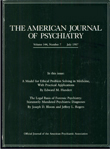Familial and sporadic schizophrenia: a symptomatic, prognostic, and EEG comparison
Abstract
The authors examined the differences between 30 patients with familial schizophrenia (those with a schizophrenic first-degree relative) and 83 patients with sporadic schizophrenia (those with a negative family history for schizophrenia). Although the two groups showed no difference in the intensity of 1) flattened, depressed, or elevated affect, 2) auditory hallucinations, and 3) delusions, more of the familial (56.7%) than the sporadic (18.1%) schizophrenic patients had severe thought disorders. EEGs were performed while the patients were taking neuroleptics; 72.3% of the sporadic schizophrenic patients and 43.3% of the familial patients had an abnormal tracing. The authors conclude that the division of schizophrenia into familial and sporadic forms may represents a valid subclassification.
Access content
To read the fulltext, please use one of the options below to sign in or purchase access.- Personal login
- Institutional Login
- Sign in via OpenAthens
- Register for access
-
Please login/register if you wish to pair your device and check access availability.
Not a subscriber?
PsychiatryOnline subscription options offer access to the DSM-5 library, books, journals, CME, and patient resources. This all-in-one virtual library provides psychiatrists and mental health professionals with key resources for diagnosis, treatment, research, and professional development.
Need more help? PsychiatryOnline Customer Service may be reached by emailing [email protected] or by calling 800-368-5777 (in the U.S.) or 703-907-7322 (outside the U.S.).



